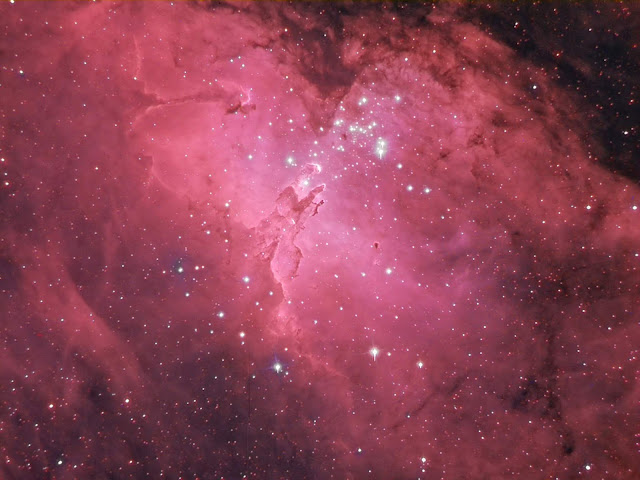Eagle Nebula and the Pillars of Creation
Situated in the heart of the summer Milky Way, this nebula represents the best proof that the galaxy is still alive and in continuous evolution. This enormous expanse of ionized gas is heated and made visible by the numerous hot, young stars born within. You can notice dark columns inside, called the Pillars of Creation. They aren’t zones lacking gas; in fact, they are anything but. There inside, hidden from view, those columns of dense, cold gasand dust are giving birth to new stars and probably planetary systems. Subjected to their own gravitational pull, those dense clouds of gas and dust begin a slow gravitational collapse which breaks them into many smaller clouds from which the single stars will be born.
The compression increases the heat in the central area, where a protostar is formed: an aggregate of gas, much more extensive than the star will be, and which only emits gravitational energy. The rotation of the gas, for the principle of preserving the angular momentum, increases little by little as it compresses, until a disc forms around the embryo star from which planets can also originate. It will take from 100 thousand to tens of millions of years to transform the protostar into an actual star, the necessary time for the compression of the collapsed gas to exceed, in its nuclear region, the threshold of the 18 million degrees necessary to light the thermonuclear motor.
Although our life is too short to see the Universe evolve, nothing remains unchanged. The entire Universe changes; stars are born, they evolve and go out. The great expanses of shine, move, dissolve; galaxies move, collide and change their shape. Nowhere, therefore, do appearances deceive as in this case: the sky seems the same to us for decades, even millennia, but we’re admiring just a frame of a movie that goes too slowly to appear to be moving. But, we can reconstruct it by looking around us into undefined space, gathering frames of events that are passing through various evolutionary stages and then doing a huge editing job to transform everything into the greatest time-lapse movie ever created by the human hand.



Comments
Post a Comment